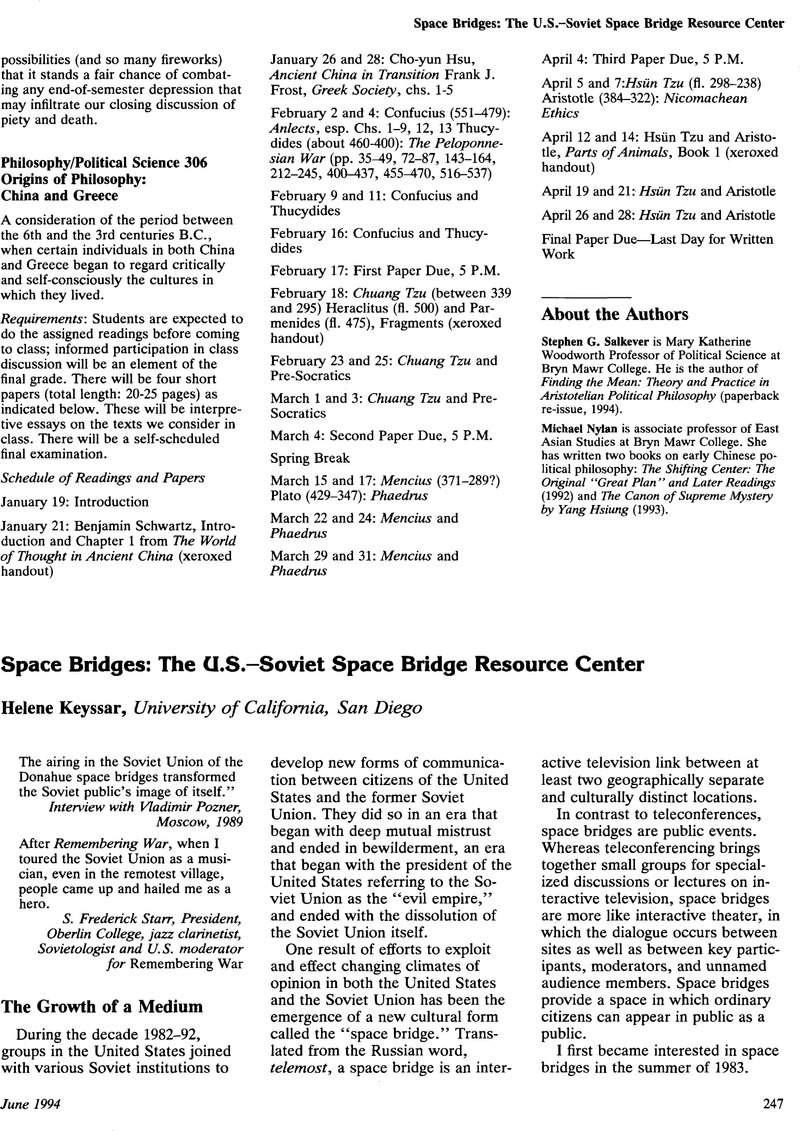Published online by Cambridge University Press: 02 September 2013

1. James Hickman, a co-producer of the two earliest attempts at space bridges between music concerts in California and studios in Moscow, has shared his unpublished account of those events with me. At the time, Hickman was director of the Esalen U.S.-Soviet Exchange Program. The UCSD Resource Center holds a copy of Hickman's 90-plus page narrative. It can be read at the archive with the author's permission. Some of the same material appears in Hickman, James, 1985. Spacebridges: A Handbook on Soviet American Satellite Communication [draft 2.5] Washington, D.C. Google Scholar Institute for Soviet-American Relations. This handbook is the precursor to the Citizen Exchange Council Handbook (1989) noted below.
2. It is worth noting that within two years, the cost of a two-hour space bridge with a one-hour edited version rose from $23,000 to $250,000. The 10-fold increase reflects the assumption that many people will contribute time and equipment once but that, subsequently, everyone involved would be paid professional salaries, equipment would have to be purchased or rented and post-production editing would be included in the original budget.
3. Some idea of this production can be found in Keyssar, Helene and Pozner, Vladimir. 1990. Remembering War: a U.S.Soviet Dialogue. New York: Oxford University Press.Google Scholar Charlie Miller's contribution appears on pp. 55–60.
4. The leading scholar on Soviet media is Ellen Mickiewicz who, from the beginning, has been supportive of the research side of this project. See Mickiewicz, Ellen, Media and the Russian Public (Praeger, 1981)Google Scholar and Split Signals (Oxford, 1988).
5. The event never actually took place. The downing of Korean Air Lines Flight 007 occurred three days before the event. For the U.S. and the Soviet Union to jointly present a television program that ignored the disaster was inconceivable. See Helene Keyssar with Michael Cole. 1984. The Dynamics of Simulcasts. Report to the Carnegie Corporation. Available from UCSD Resource Center.
6. My main source of evidence of this is several interviews with Vladimir Pozner, including one in which he read me a number of letters from Soviets and Americans. Interviews with Soviet producers Pavel Korchagin and Sergei Skvortsov confirmed the tone and content of many Soviet responses.
7. Jennings, Peter. 1989. “Telesummitry.” In Spacebridges: Television and U.S.–Soviet Dialogue, ed. Brainerd, Michael. Lanham, Md:Google Scholar. A useful book for students and potential producers, this Citizens Exchange Council publication includes some space bridge history, a bit of context setting and useful “how to” hints. Jennings' comments create a provocative dialogue with his on-air performances.
8. Interview in Moscow with Sergei Erofeev (1988).
9. Bakhtin, M.M. 1981. The Dialogic Imagination. Austin: University of Texas Press, p. 416–419.Google Scholar
10. Morson, Gary Saul, ed. 1986. Bakhtin: Essays and Dialogues on his Work. Chicago: University of Chicago Press.Google Scholar
11. I wish to thank Charles Benton for his persistent support of my research and especially for his encouragement of the thinking I have been doing along these lines of creating new forms of television through intercultural production. I am deeply appreciative to the Benton Foundation and the MacArthur Foundation for their support of my research and production. Many thanks especially to Michael Cole without whom none of this could have possibly started or continued and to Tracy B. Strong for continuing help and support.